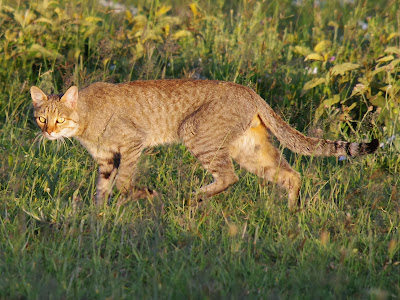Felidae is the over-arching family of mammals to which all the species that we both correctly or colloquially call cats, belong. Domestically, I'm probably more of a cat person than I am a dog person, although, as a family, we've had both as pets over the years.
When I first went on Safari, I don't think I gave much thought to looking for either cats or dogs of any sort on my journey. I went to see elephants and they were all-absorbing. By my second safari, I was more aware of the possibilities and better prepared to see some of these magnificent creatures in their natural habitats. Through many subsequent trips, I have been lucky enough to see several different cat species and photograph many of them very successfully. That's not to say that my cat-spotting journey is over; indeed I'm heading to India next year to try and add to the list with some of the most magnificent of all the Felidae.
Lions
If you ask someone to think of a cat species, then chances are, if talking about across the whole world, the answer might well be lion. I'm pretty sure that tiger will be a close second, but lions get the lion's share of the press - pun intended.
I've been lucky enough to see lions in Kenya, Tanzania, Uganda, Zambia and Namibia so far. They are always relaxed, always in control and always magnificent. They are also, often but not always, fast asleep.
Still, here are a few from various destinations in various states of wakefulness.
 |
| Family Portrait, Ndutu, Tanzania |
 |
| Ndutu, Tanzania |
 |
| Ishasha Sector, Queen Elizabeth N.P., Uganda |
 |
| Etosha National Park, Namibia |
Leopards
If I have a favourite of all the cat, then this is the one. Where lions are somehow predictable in their laziness, leopards are quite different. The have that special, almost unnerving, I-don't-give-a-shit attitude that I just find captivating.
They are also pretty hard to see. You need more than a little luck and sightings are often difficult or fleeting or both. Over many trips, then, I've been incredibly lucky. From that first tree-top sighting in the Serengeti to seeing four different leopards on Christmas Day in Zambia, I simply never get tired of seeing another one.
 |
| At rest, Serengeti Plains, Tanzania |
 |
| South Luangwa National Park, Zambia |
 |
| Etosha National Park, Namibia |
 |
| Ruaha National Park, Tanzania |
Cheetah
My sightings of cheetah have so far been confined to only Tanzania and Namibia. Namibia was also cheating in a way, as we were visiting the CCF sanctuary for exercise time. Still, a chance to see some of these elegant and delightful cats up close - very close.
Sightings in Tanzania were much more spontaneous and impressive. I didn't get to see one at a full run, but even at half-speed and just testing the skittishness of the herd was impressive.
 |
| In the shade, Ndutu, Tanzania |
 |
| On the hunt, Ndutu, Tanzania |
 |
| Testing the herd, Ndutu, Tanzania |
 |
| On the prowl, Ruaha, Tanzania |
 |
| At speed, Cheetah Conservation Fund, Namibia |
Serval
I might have honestly never expected to see this one. We went into Ngorongoro Crater with high hopes of seeing lions - it is a lion population hot-spot after all - but knew there'd be little chance of seeing other cats.
This one was quite a distance away - at the limits for my 500mm telephoto - but it was still a wonderful sighting of a stunningly beautiful cat. I have a few photos that, like this one below, don't really do it justice.
African Wildcat
This one was even more of a surprise. We'd had a great day out on the plains. There'd been tens of thousands of wildebeest and other game. We'd seen the lions on a kill and then the cheetah brothers resting in the shade. This was just the icing on the cake.
The similarity to a domestic cat is uncanny. A little bigger, bolder and simply wonderful, this one was clearly heading out into the twilight to hunt.
Now we come to the first of two species that I don't have a photo for. Caracal are common enough, by all accounts, but secretive and elusive. Our potential sighting at the given location was later confirmed by the staff at the lodge.
Driving around Lake Masek at Ndutu in Tanzania, we rounded a corner in the road and both my friend Fred and myself sighted a medium-sized cat in the road. I barely managed to conclude that it had ear tufts before it bounced over a large bush and vanished into the dense undergrowth. We both called Caracal at the same time, but it was gone.
African Golden Cat
Again, not one that I have a photograph of, but then very few people in this world do have a picture of one in the wild. A scan of images on a google search will find quite a few taken with automated camera traps or in captivity, but very little taken in the wild. They are secretive and well-camouflaged.
Ithumba, in Tsavo East National Park, in Kenya, is at the very extreme eastern edge of their range, but again their presence was confirmed by wildlife service and lodge staff. We had stopped the vehicle to look at some birds, but for just a moment, Fred and myself were looking directly forward down the dirt track when a medium-sized cat walked slowly across the road at more than 100m away from us.
In that few seconds I didn't get a chance to lift the camera to my eye and neither did Fred. Again, the hint of a tufted ear, but markings on the flanks that ruled out the Caracal. It could be only one thing.





